Artists for Nature (ANF)
Visit to Hula Valley, Israel. March 6th - 16th 2009
I have been lucky enough to have been involved in many of
the 12 or more projects which the Artists for Nature Foundation (ANF) has been
associated over the past twenty or so years - from Spain, to Peru, India,
Alaska and many other countries where art can be used to support and promote
important conservation issues. See the ANF website
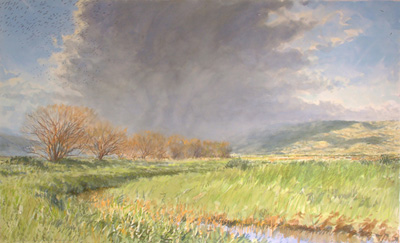 (Above) Migration north along the Hula valley (and
approaching storm coming off the Syrian highlands and Mount Hermon). Historically the Hula valley was a vast swamp of papyrus, lakes, mud and marsh created over millennia by the natural low gradient of the Jordan River which flowed into the north end spilling out over an area of almost 50 square kilometres and at its southern end a vast basalt plug restricts the flow of the Jordan lower down towards the Sea of Galilee and on to the Dead Sea. Winter rains enlarged the wilderness that was a home for countless wild animals and many species of wild birds and a vital stopover site and seasonal home for many millions of migratory birds. Until fairly recent modern times, the Hula Valley was a malarial area inhabited only by a few Arab villagers and was left desolate until the very early days after the establishment of the state of Israel in 1948. In need of food and an agricultural industry to support the fledgling state the new government decided to drain the swamps of the Hula beginning in 195, and by 1958 all except a small section retained as a nature reserve was reclaimed land. The valley had become a complex of drainage and irrigation canals and the basalt dyke at the north end of the Sea of Galilee was blasted away to provide a better channel for the Jordan, which was canalized through most of the valley. 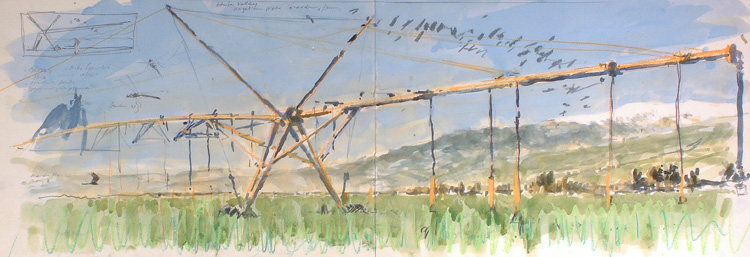 (Above) Irrigation system with cranes coming down into the fields beyond, (with distant Mount Hermon and Golan Heights in the background). Watercolour and crayon. 84cm x 30cm The reclaimed land provided some of Israel’s richest farmland and was planted with grains, fodder crops, fruits (especially apples), peanuts (groundnuts), cotton, vegetables, and bulbs for export. However, although initially perceived as a great national achievement for Israel, with time it became evident that the benefits from transforming the "wasteland" of Lake Hula and its swamps were limited. In the past few years, following nearly 50 years of an unsuccessful struggle to utilize the drained valley's resources, the Israeli government has finally recognized that successful development can endure only if a balanced compromise between nature and development is reached. By the early 1990s, sinking groundwater levels and other unforeseen environmental consequences of the reclamation project had rendered some farmland unusable and prompted efforts to turn a portion of the Hula Valley back into a natural wetland. 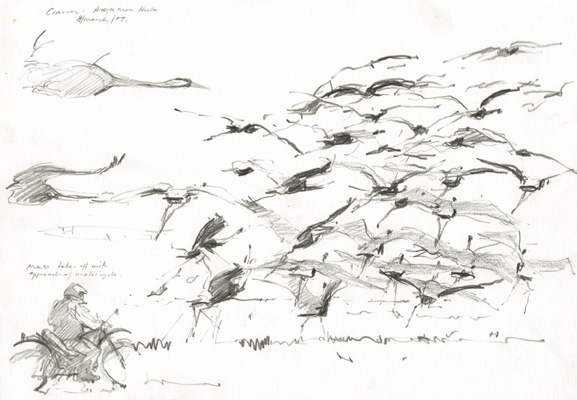 (Above) A3 pencil sketch of cranes being moved on. The conflict between the large number of wintering cranes and agriculture - the birds flock onto the surrounding fields to feed - is evident every moment every day! The tracks, paths and roadways criss-crossing the valley are busy with the traffic of bird scarers on motorbikes or 4x4s blaring sirens 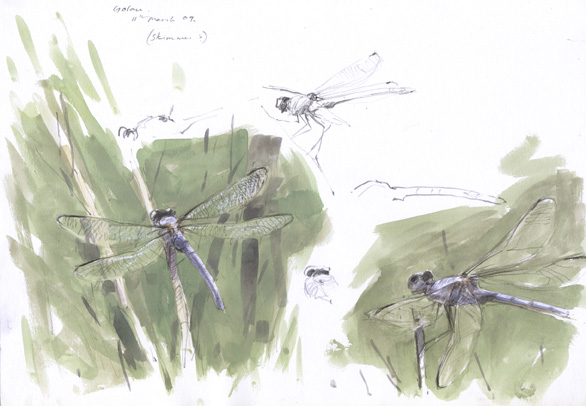 (Above) A3 sketches of possible epaulet skimmer. (No book avilable, but checked by local expert!). Return to Homepage |
 (Above)
The Hula Valley and Golan Heights with flocks of cranes and storks
moving north. Watercolour and pencil 80cm x 30cm
(Below) A3 crane sketches. Over 10,000 birds now winter in the Hula Valley. 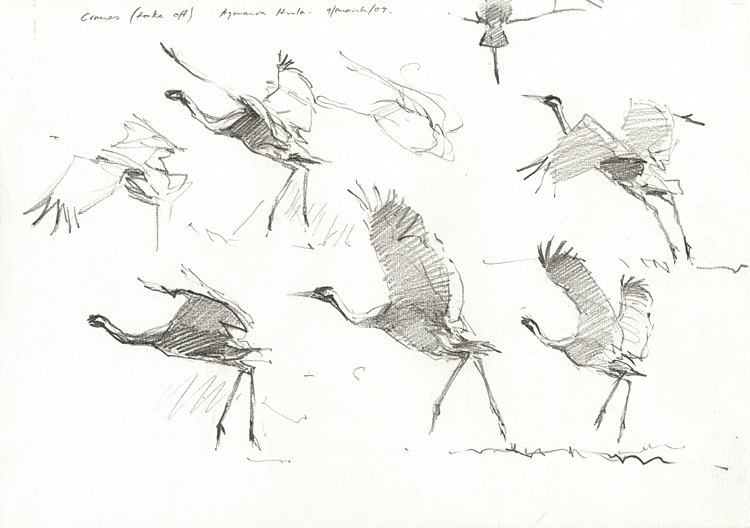 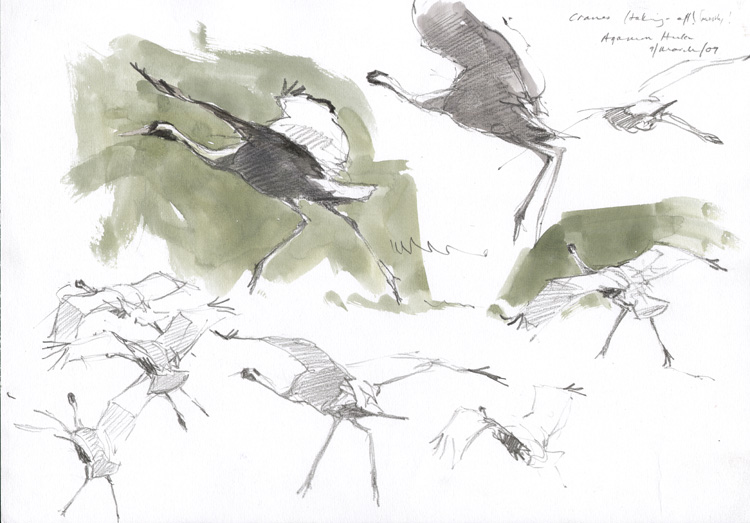 Agamon Hula (abbreviation from the Hebrew Agamon Ha Hula, literally meaning "Little Hula Lake") is a nature reserve that attracts huge numbers of visitors. Located in the southern part of the valley, in the area that once served as the transition between Lake Hula and the surrounding swamps, it was created as part of the rehabilitation program of the valley. This new lake is shallower and much smaller than the original lake. A really good feature of the reserve are the walkways through the reed and papyrus bridging the open channels. Sitting quietly for a while on the viewing platforms and bridges there are wonderful views to be had of dragonflies and damsels, and terrapins and huge catfish moving through the clear peaty water below. 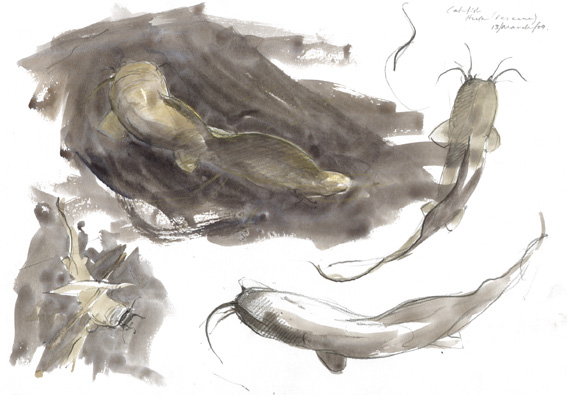 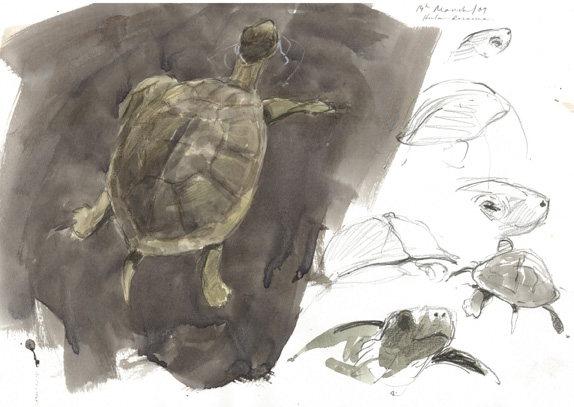 (Above) A3 sketchbook pages of catfish and terrapins. Some of the fish were absolutley enormous! 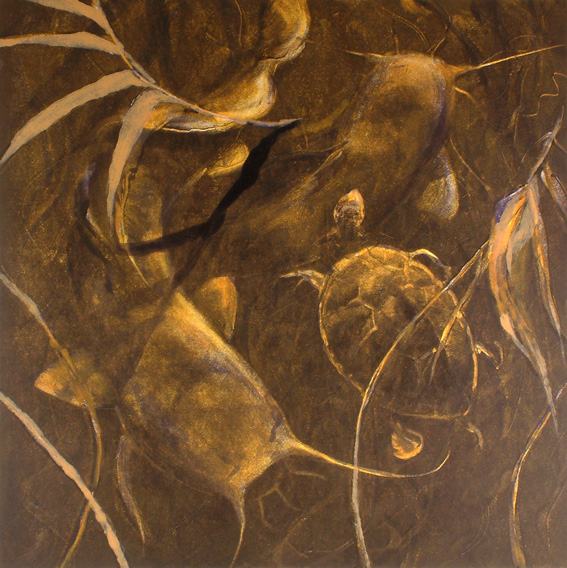 (Above) Terrapin and Catfish. Monotype (60cm x 60cm) |